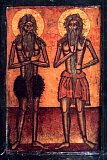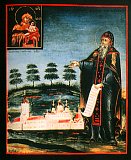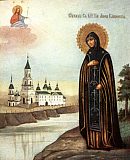

| Previous day | Next day |
| Old Style
June 12
|
Tuesday |
New Style
June 25
|
| First Week after Pentecost (Fast-free period). Tone 7. | No fast.
|
![]() St. Onuphrius the Great (4th c.).
St. Onuphrius the Great (4th c.). ![]() St. Peter of Mt. Athos (734).
St. Peter of Mt. Athos (734).
Sts. John, Andrew, Heraclemon, and Theophilus, hermits, of Egypt (4th c.). St. Arsenius, founder of Konevits Monastery (1447). St. Onuphrius, founder of Malsk Monastery (Pskov) (1492). Sts. Onuphrius and Auxentius, monks, of Vologda (15th c.-16th c). St. Stephen of Komel, founder of Ozersk Monastery (Vologda) (1542). Sts. Jonah and Bassian, monks, of Pertoma (Solovki) (1561). First (1650) and second (1909) glorifications of St. Anna, princess of Kashin (Euphrosyne in monasticism). St. Onuphrius, founder of Katrom Monastery (Vologda) (16th c). Uncovering of the relics of St. John of Moscow, fool-for-Christ (1672).
Miracle-working icons of the Theotokos and St. Onuphrius at St. Onuphrius Monastery (Poland). Valaam Icon of the Most Holy Theotokos.
St. Amphianus, bishop and confessor, in Cilicia (ca. 310). St. Olympius, bishop and confessor, in Thrace (4th c.). St. Timothy the Hermit, of Egypt (4th c.). Virgin-martyr Cunera of Rhenen (Neth.) (451). St. Julian of the Dagouta Church in Constantinople. St. John the Soldier, of Egypt (6th c.-7th c.). St. John (Tornicus) of Mt. Athos and Georgia (998). Synaxis of the Saints of St. Onuphrius Monastery at Jablechna (Poland). St. Triphyllius, bishop of Leucosia [Nicosia] on Cyprus (370). St. Nicephorus (Cantacuzene), archdeacon, of Constantinople, who suffered under the Uniates in Marienburg, Galicia (1599).
Repose of Elder Peter of Katounakia, Mt. Athos (1867), and Blessed Hermit Philaretus of Mt. Athos (1961).
Thoughts for Each Day of the Year
According to the Daily Church Readings from the Word of God
By St. Theophan the Recluse

Tuesday. [Rom. 1:1–7, 13–17; Matt. 4:25–5:13]
After the Lord’s baptism, when the Spirit descended upon Him in the form of a dove, He was brought down into the wilderness to be tempted. Such is the path common to all. Saint Issac the Syrian notes in one place that as soon as you taste grace-filled consolation, or receive some gift from the Lord—await temptations. Temptations conceal the brightness of grace from one’s own eyes which usually consume every good with self-opinion and self-exultation. These temptations are sometimes external—sorrows, humiliation; and internal—passionate thoughts, which purposely are released, like beasts unchained. Therefore, we must heed ourselves and strictly sort out what occurs with us and in us, to see why it is happening, and what obligations it brings.
Articles
 Venerable John the Hermit of EgyptSaint John the Hermit lived in Egypt in the fourth century, and is mentioned in the Life of Saint Onuphrius. |
 Venerable Andrew the Hermit of EgyptSaint Andrew lived in Egypt in the fourth century, and is mentioned in the Life of Saint Onuphrius. |
 Venerable Heraclemon the Hermit of EgyptSaint Heraclemon lived in Egypt in the fourth century, and is mentioned in the Life of Saint Onuphrius. |
 Venerable Theophilus the Hermit of EgyptSaint Theophilus lived in Egypt in the fourth century, and is mentioned in the Life of Saint Onuphrius. |










